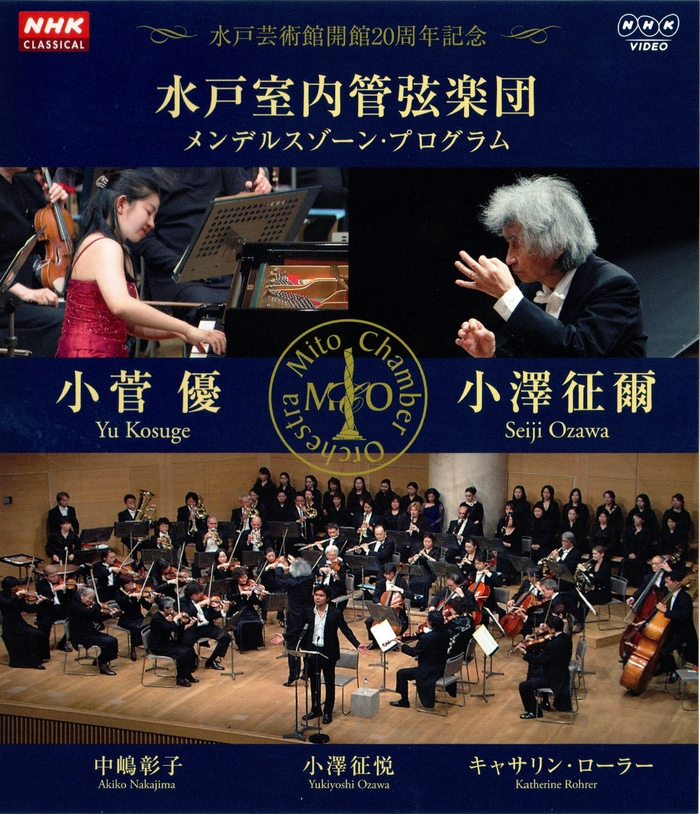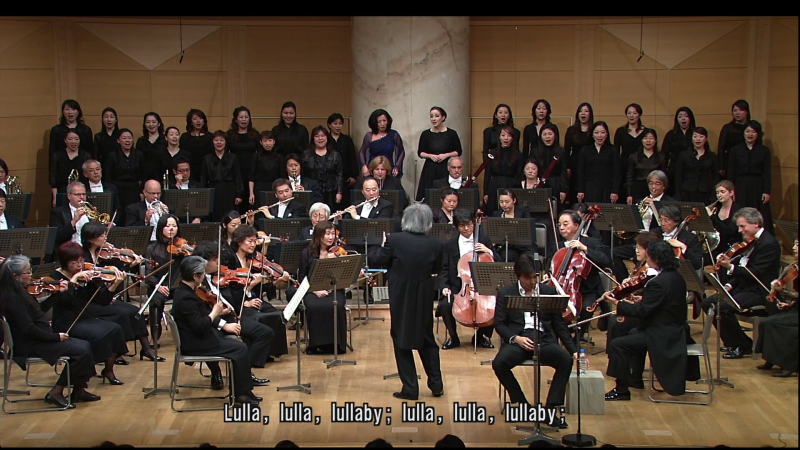

Mendelssohn Piano Concerto No. 1 and Sommernachtstraum or Music to A Midsummer Night's Dream. Seiji Ozawa conducts a 20th-year anniversary concert of his Japanese Mito Chamber Orchestra in 2009 at the Mito Art Tower. Yu Kosuge is the piano soloist. For A Midsummer Night's Dream, the orchestra is joined by soprano Akiko Nakajima, mezzo Katherine Rohrer, ladies of the Tokyo Opera Singers (Chorus master: Masanori Mikawa), and narrator Yukiyoshi Ozawa (Seiji's son, an actor). There is also an 8-minute bonus of the Bach Air on the G String from the Orchestral Suite No. 3 in D major. The information in the collector's booklet is 99+% in Japanese, but there are nice subtitles in English on the disc. This title was recorded with 96kHz/24 bit sound sampling on all tracks. The disc has 5.0 PCM sound output. Grade: A+ for both performances.
Two delicious confections from the Mendelssohn Konditorei! This title was made in Japan primarily for their home market. The Mito Chamber Orchastra, promoted by Seiji Ozawa, is an elite western-style chamber orchestra in Japan with star Japanese musicians and a few European players. Written material on the keepcase, booklet, and disc is almost entirely in Japanese. But there is just enough information in English for a westerner to work his way through the menus. And for the speaking and singing portions of the disc, there are English subtitles. This is more than just a delightful music recording. It's proof from the Japanese Broadcasting Company (NHK) that Japanese musicians can compete with the best in the world and that NHK can make a better HDVD of a symphony than the European and Americans.
Mendelssohn Piano Concerto No. 1
We start with Yu Kosuge as piano soloist in the Mendelssohn Piano Concerto No. 1. After you work your way through the menu, here's the title screen:
With only 36 players and a soloist on stage, it's relatively easy for the TV director to follow the the best-practice standards for making an HDVD of a symphony orchestra. The most important single good practice is to give the audience plenty of whole-orchestra shots. In the screenshot below we see the best view of the whole orchestra in this track—you can see all the musicians except for a couple of second violinists who are partly obscured by the piano and the conductor. There are many long-distance shots with this and other angles:
Yu is an energetic performer who is fun to watch:
Following best practices, there are only a couple of shots of Ozawa such as the one below. The emphasis is all on the soloist:
The TV director also was alert to show sections at work. For example, here during the Andante there's a mellow, languid theme with the low strings (violas, cellos, and double-basses) and a single horn playing to the soloist. The camera catches this in a smart, perfectly framed shot that shows all the active players as well as the resting second horn at the edge. In this shot you see exactly what you are hearing:
I ran the numbers in a Wonk Worksheet for this Mendelssohn Piano Concerto No. 1, and this revealed just how good this recording is. The pace is a satisfying 15 seconds per clip on average. There are only 85 clips. 51 of these are supershots for a for a supershot percentage of 60%. Only 9% of the shots are of the conductor. 16 clips of the soloist last more than 15 seconds, 9 clips last more than 30 seconds, and 1 clip last more than a minute. This recording can be a reference for the excellent HDVD of a piano concerto.
A Midsummer Night's Dream
Mendelssohn's music for A Midsummer Night's Dream is complete with the Overture (written when Mendelssohn was 17) and the Incidental Music (written when Mendelssohn was 35). I was familiar with this music from the A Midsummer Night's Dream Ballet recorded by the Pacific Northwest Ballet. I could tell that the singers on that disc were rendering poetry from Shakespeare, but I could not understand a word.
Below from the Midsummer Night's Dream segment are two fine whole-orchestra shots of the full Mito chamber orchestra plus soloists and the chorus. The TV director gives us many such shots, and he often lets them run on for up to 45 seconds. Just think—a TV director who actually lets you relax and enjoy watching and hearing the orchestra for a satisfying period of time before snatching you away to another view. In the first view below, you can see all the violins playing together. In the second view you see all five strings sections at work. Multi-section shots like these are almost never seen in the DVDitis-infected symphony titles we get these days from the European and American Blu-ray publishers:
A typical part-orchestra shot provides variety with strings and some winds engaged:
Of course, with this longer piece, the TV director has opportunity to move in for a variety of close-ups. Here's a rare lady tympani player:
A nice shot of the cellos:
A fantastic shot of misterious passages for the woodwinds playing softly. If you know this piece well you will probably be able to hear the music in your head just from seeing this.
Surprise, the music will be narrated by Yukiyoshi Ozawa, an actor and the son of the conductor:
Yuki narrates in Japanese to give the home audience a better idea what the music is about. Here's Yuki's first declamation in Japanese:
And here's the same shot with English subtitles:
Now we meet the soloists:
Mezzo Akino Nakajima sings in English! There are subtitles in English and Japanese. Her diction is unbelievebly good. But having the subtitles clinches it for me—now I learn what passages from Shakespeare Mendelssohn set for voice:
And now the American soprano Katherine Rohrer comes in. You sense from sight and sound how much fun everybody is having doing this:
And finally the sublime voices of the chorus:
Yuki gives the Japanese audience some inkling about what goes on in this complicated story of fairies, lovers, and weddings. When Kuki speaks, the orchestra pauses:
And here all rest while the first violins softly play the theme of the sleeping Queen Titania. The camera sucks this up, and it's enough to make you want to cry:
My daughter, who prefers rock music to classical, will burst into the home theater, mouth agape, at the sound of the famous wedding march. That's one part of classical music that she gets:
The narration continues:
Now the chorus comes back in. It chokes me up that I now learn from the beautiful ladies of the Tokyo Opera which of Shakespeare's lines are set to music here! They worked hard to master the difficult, concentrated words of our Bard so well that they are mostly understandable even without the subtitles!
This is one of the few HDVDs that goes into technical specifications of the sound recording in detail in the keepcase booklet (none of which I can read, of course).
The quality of the music making is high and especially impressive considering short history of western music in Japan. The SQ is excellent with audiophile level specs throughout. PQ is fine even if the resolution is a tad bit soft. Most impressive is the fine video content following best practices for a video made with the sole objective of taking full advantage of HD cameras. (If this had been shot in Europe or the US, the producer would have made a DVD and then used that video for the Blu-ray version as well. See our article on standards to learn more about why we call this practice "DVDitis.") There are a few weak conductor-over-the-backs-of musicians shots; but otherwise, this is a luminous, precious, and exemplary Blu-ray video. Grade: A+


























